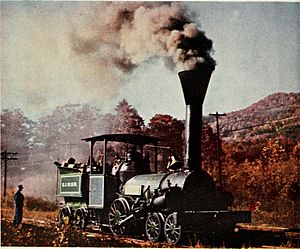The Great Locomotive Chase facts for kids
Quick facts for kids The Great Locomotive Chase |
|
|---|---|
 |
|
| Directed by | Francis D. Lyon |
| Produced by | Lawrence Edward Watkin Walt Disney |
| Written by | Lawrence Edward Watkin |
| Starring | Fess Parker Jeffrey Hunter John Lupton Jeff York Slim Pickens |
| Music by | Paul J. Smith |
| Cinematography | Charles Boyle |
| Editing by | Ellsworth Hoagland |
| Studio | Walt Disney Productions |
| Distributed by | Buena Vista Distribution |
| Release date(s) | June 8, 1956 |
| Running time | 85 minutes |
| Country | United States |
| Language | English |
| Money made | $1.7 million (US) |
The Great Locomotive Chase is an exciting adventure movie from 1956. It was made by Walt Disney Productions. The film tells the true story of a daring event called the Great Locomotive Chase. This event happened in 1862 during the American Civil War.
The movie was filmed in color using CinemaScope, which made the screen look extra wide. It stars Fess Parker as James J. Andrews. He leads a group of Union soldiers. These soldiers dressed in regular clothes and went behind enemy lines. Their mission was to steal a Confederate train in Georgia. They planned to drive it back to Union lines in Tennessee. Along the way, they would rip up railroad tracks and destroy bridges and telegraph lines. This would stop the Confederate army.
The film was written and produced by Lawrence Edward Watkin and directed by Francis D. Lyon. It also features actors like Jeffrey Hunter, John Lupton, and Slim Pickens. The music was composed by Paul J. Smith. The movie was filmed in Georgia and North Carolina. It came out in U.S. theaters on June 8, 1956.
Contents
The Daring Plan
On March 25, 1863, a soldier named Cpl. William Pittenger and seven others were called to the U.S. War Department. They were there to receive the very first Medals of Honor. Pittenger then tells the story of their secret mission through a flashback.
In April 1862, Pittenger and other soldiers were near Nashville. They were under orders from General Mitchell. James J. Andrews arrived to meet General Mitchell. Andrews was given a special mission. He had to hijack a train behind Confederate lines. Then, he needed to destroy bridges along the Western and Atlantic Railroad. This would slow down Confederate soldiers. It would also hurt their supply lines, possibly ending the war.
Pittenger, William Campbell, and other soldiers met Andrews that night. Andrews explained the mission. He told them to meet in Marietta, Georgia by April 10. Over the next few days, the men traveled south in small groups. This helped them avoid suspicion. Pittenger and Campbell met Andrews and two others at an inn. Bad weather caused Andrews to delay the mission by a day.
The Chase Begins
On the morning of April 12, Andrews and his team met at a hotel in Marietta. They boarded a train heading north. The train was pulled by a locomotive named the General. They waited for the breakfast stop at Big Shanty.
While on the train, the conductor, William A. Fuller, became suspicious of Andrews. Andrews showed Fuller a letter from Brigadier General Beauregard. This made Fuller believe Andrews and his men were Confederate agents.
When passengers and crew were eating breakfast, Andrews and his men quickly unhooked the passenger cars. They then hijacked the General engine and sped north. Conductor Fuller saw this happen. He immediately started chasing them on foot. Engineer Jeff Cain and foreman Anthony Murphy joined him.
Andrews and his men continued their escape. They pulled up tracks to block any trains coming from the south. They also cut telegraph wires. This stopped towns ahead from being warned. Fuller and his men kept chasing them. First, they ran on foot. Then they used a handcar. After that, they used a small yard engine called the Yonah.
A Race Against Time
The raiders made a planned stop at Kingston. They waited for a southbound freight train. Andrews pretended to be running an ammunition supply train for Beauregard. This fooled the station staff.
When the southbound train arrived, the raiders learned something new. General Mitchell had captured Huntsville earlier than expected. This meant the Confederates were now running extra freight trains south. Another unscheduled train was also coming from the north. After waiting 45 minutes, the last train arrived. The raiders then continued north.
Soon after, Fuller and his men reached Kingston. Fuller told the station master what happened. Then, Fuller and his men took a locomotive called the William R. Smith. They continued the chase until they found another section of missing track. Fuller and Murphy then stopped Pete Bracken and his southbound express freight train. They continued the chase using his engine, the Texas, running it backward!
The End of the Chase
The raiders tried several times to stop their pursuers. But they barely managed to slow them down. The raiders reached the first bridge. They tried to burn it down by lighting a boxcar and setting its brake. This was meant to keep it from moving. However, Fuller managed to release the brake. The Texas pushed the car out of the way, leaving the bridge unharmed.
The General ran out of wood and water. It could not go on. Andrews decided to stop and fight. But before they could, Confederate cavalry arrived from Ringgold. General Leadbetter had sent them after Fuller managed to send a telegraph ahead.
Fuller arrived and took back his train. The raiders, having failed their mission, ran into the wilderness. They tried to make their way back home.
After the Chase
Over the next week, the raiders were hunted down and captured. They were moved from jail to jail across the South. They learned they were found guilty and faced serious consequences.
One day, while in their cell in Atlanta, one of them broke their chains. They planned to escape the next morning. All the men made it over the jail yard wall except Andrews and Campbell. They stayed behind to fight off their captors. Eight of the raiders, including Pittenger, managed to escape. The rest were recaptured.
Before his execution, Andrews asked to see Fuller one last time. Fuller reluctantly came. Andrews hoped Fuller would not hold a grudge. He said they both fought in their own ways. Andrews wished he would live to see the end of the war. He hoped to see both sides come together and shake hands. He asked Fuller if they could do so instead. Fuller agreed, marking the end of their personal conflict. This brought Andrews peace.
Back in the opening scene, Secretary Stanton told the eight surviving raiders that their friends who died would also receive the Medal of Honor. This included everyone except Andrews, who was not eligible as he was a civilian. Pittenger thanked Stanton for all the raiders. This is how the film ends.
Cast of Characters
- Fess Parker as James J. Andrews, the Union spy and leader
- Jeffrey Hunter as William A. Fuller, the Confederate train conductor
- Jeff York as William Campbell, a Union civilian volunteer
- John Lupton as Cpl. William Pittenger, a Union soldier
- Eddie Firestone as Robert Buffum, a Union soldier
- Kenneth Tobey as Anthony Murphy, a Confederate railroad superintendent
- Don Megowan as Marion A. Ross, a Union soldier
- Claude Jarman, Jr. as Jacob Parrott, a Union soldier and first Medal of Honor recipient
- Harry Carey, Jr. as William Bensinger, a Union soldier
- Leonard P. Geer as James A. Wilson, a Union soldier
- George Robotham as William Knight, a Union soldier and train engineer
- Stan Jones as Wilson W. Brown, a Union soldier and train engineer
- Marc Hamilton as John Wollam, a Union soldier
- John Wiley as John M. Scott, a Union soldier
- Slim Pickens as Pete Bracken
- Morgan Woodward as Alex, a Confederate soldier
- W.S. Bearden as Switchman
- Harvey Hester as Jess McIntyre
- Chuck Roberson as Confederate Prison Captain (uncredited)
- Dick Sargent as Unnamed Union soldier (uncredited)
- Dale Van Sickel as Alonzo Martin (uncredited)
Making the Movie
Filming Locations
By the 1950s, the original Western and Atlantic Railroad tracks looked very modern. They were not suitable for a Civil War movie. So, Disney studios looked about fifty miles east. They found the Tallulah Falls Railway. This railway was a bit old but very scenic. It had great curves and wooden bridges. The film was shot along 35 miles of this railway. This was between Franklin, North Carolina and Cornelia, Georgia.
Trains in the Movie
The movie used different locomotives to play the real ones. The first locomotive chased by Fuller, the Yonah, was played by the Lafayette. This was a replica built in 1927. The original Yonah looked a bit different.
Two of the actual locomotives from the real chase, the General and the Texas, were preserved. But they were not working in 1956. It would have cost too much to make them run safely. Luckily, Disney found two working locomotives that looked very similar. These were the William Mason and the Inyo. Both had been in other movies.
For the film, the William Mason was painted to look like the General. The Inyo played both the Texas and the William R. Smith. Disney rented the Inyo from Paramount Studios. The Mason and Lafayette were rented from the B&O Railroad Museum. Five Civil War-era train cars were also rented. These included two coaches, a baggage car, and two iron ammunition cars. The studio also built five wooden boxcars. These could be, and were, destroyed during filming.
Where Are the Trains Today?
As of March 2021, the locomotives from the real chase and the ones used in the film are in different places:
- The General is at the Southern Museum of Civil War and Locomotive History in Kennesaw, Georgia.
- The Texas is at the Atlanta History Center in Buckhead.
- The Lafayette (which played the Yonah in the film) is at the B&O Railroad Museum.
- The William Mason is also at the B&O Railroad Museum.
- The Inyo is at the Nevada State Railroad Museum in Carson City, Nevada. It sometimes even runs!
Songs from the Movie
Here are the songs featured in the film:
- "Dixie"—sung by Fess Parker and others.
- "A Rebel I Will Be Until I Die"—sung by Morgan Woodward.
- "Sons of Old Aunt Dinah" - with lyrics by Lawrence Edward Watkin and music by Stan Jones, sung by Morgan Woodward and others.
- "I Stole A Locomotive Just to Take a Ride 'Cause My Daddy Was A Railroading Man"—sung by Jeff York, John Lupton, and others.
- "Roll Jordan Roll, I Want To Go To Heaven When I Die"—sung by Fess Parker and others.
- "Tenting On the Old Camp Ground"—a classic Civil War song sung by Fess Parker, Jeff York, John Lupton, and others.


